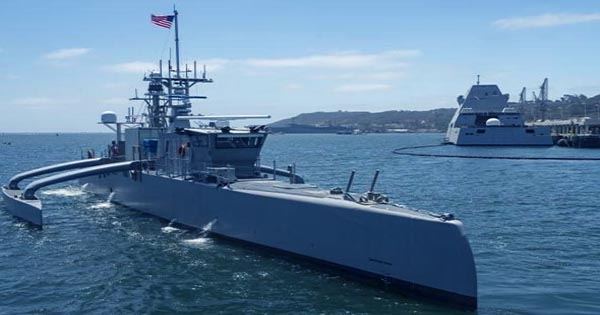The first missile has been fired by the Pentagon’s crewless robot ship.
In a test for the US Navy’s Ghost Fleet experimental program, the Unmanned Surface Vessel (USV) Ranger launched a Standard Missile-6 (SM-6) in a video published by the US Department of Defense (DoD). The SM-6 is a 6.6-meter (21.5-foot) anti-air and anti-ship missile that is launched from a ship. It can also safeguard ships from incoming ballistic missiles by intercepting them.
Little is known about the missile launch outside this spectacular video montage (turn on the sound for the epic accompanying soundtrack), though the Pentagon has already revealed details about their fleet of crewless ships, known as Ghost Fleet Overlord. The Department of Defense reported the achievement of a second long-range autonomous ship excursion in June 2021, after an uncrewed vessel dubbed Nomad traveled 8,187 kilometers (4,421 nautical miles) from the Caribbean Sea to the Pacific Coast via the Panama Canal. Surprisingly, up to 98 percent of this travel was completed without human intervention.
Ranger, the ship that launched the missile yesterday, made a similar journey in October 2020. Two more uncrewed Ghost Fleet Overlord ships are now being built and will be employed in the Navy’s research and development of this innovative technology.
While autonomous military ghost ships launching nukes may sound like something out of a dystopian nightmare, they are expected to make a big mark in the coming years.
Even outside of military uses, crewless vessels have a number of advantages in civilian navigation. Human mistake is responsible for three-quarters of marine mishaps, and AI could eventually show to be far safer than a human helm. Crewless ships could be designed lighter, requiring less crew space and lowering fuel consumption, environmental effect, and expenses. There are certain drawbacks right now, including reliability, liability difficulties, and the potential of cyberattacks, to name a few. However, it appears that the age of the crewless spacecraft has arrived.
There have been tales of ghost ships for as long as there have been sailors sailing the high seas. It’s difficult not to be drawn into these tales of mysterious happenings on the great waterways of our planet, from legends of the Flying Dutchman appearing near ports during bad weather to the very real story of the Mary Celeste, which was discovered adrift in the Atlantic Ocean in 1872 completely abandoned and in good working order.
Of all, at an era when long and often arduous travels over the high oceans were the norm, it’s understandable that men and women would go missing. Despite humanity’s dominance over nature, the sea has always been too large and dangerous to control. Traveling across the ocean was always a risky enterprise for much of humanity’s history.
However, by the early 1940s, sea travel had become far less dangerous, and humanity had even discovered new means to evade the ocean’s fury, such as soaring high above it in planes or hot air balloons.













